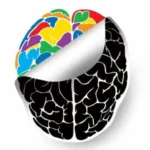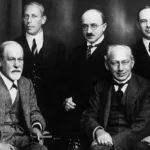
We live this way, frenetic, non-stop, many times because we are afraid of silence, non-activity, nothingness, emptiness. It represents stopping looking outside to look inside and in this way we do not want to face what we see.
In this sense, in this article I will raise the possibility of living differently: focused on the “here and now”, “realization” and the sense of our responsibility, the three pillars of Gestalt Therapy.
I will take a journey through the era in which it emerged, how and why it is called conscious therapy, the differences with other psychological approaches and who it is directed at. Also the reason why Gestalt therapists must carry out a long therapeutic process before facing our patients or clients.
Let’s start at the beginning…
Gestalt Therapy is included within humanistic psychology. This was born in the 50s/60s as a reaction to psychoanalysis and behaviorism. It is the so-called third way. Its primary figures are Abraham Maslow and C. Rogers.
Gestalt Therapy emerged in the 70s through the work of the couple Frizt Perls and Laura Posner. Fritz, a psychoanalyst, wants to redirect psychoanalysis and review errors, but Freud never wanted to listen to him, so Perls created a new school in the United States.
A conscious therapy
As the main differences with what we know as cognitive-behavioral therapy and psychoanalysis, the therapist-patient relationship changes: it becomes one on one, close, warm and active. It is the basis of therapy: the relationship that exists between the two people.
Compared to rationalization, in Gestalt experience, the phenomenological, takes precedence. We work on the emotional and also on the physical so that there is a true balance between mind, emotion and body.
At Gestalt we start from the educational model instead of the medical model. We accompany the person to find their own resources. The person is the resource itself. There is no “therapist” who is above the patient and gives him the tools to “cure” him. At Gestalt we are in contact with what happens to the person and we accompany them. For example, if the patient feels afraid, we feel it too and we accompany him in that fear that is no different from ours.
We do not diagnose according to tables or parameters. We put the origin before the symptom, since this can be shown in one way or another and will always appear again unless we manage to solve its origin. It is a holistic therapy, it treats the person as a whole.
We avoid interpretation and advice and make it easier for the patient to contact their own experience and take the consequences for themselves.
Is for me?
This therapy is aimed not only at people with problems, but also at anyone who is going through a crisis and thinks they need help. Sometimes, we realize that what used to work for us no longer works for us, and we haven’t found something new. In the different areas of my life: work, partner, children, family of origin, I feel like I am trapped and I can’t find a way out.
With Gestalt Therapy we help you get out of these alleys to go from your comfort zone to a place from where you see life in a more loving way.
If you feel strange because what has worked for you until now does not work for you, if you feel like expressing things that you have kept inside of you and need to share, if any emotion (sadness, anger…) is asking for passage, if you find it difficult to manage your fears If you are tired of always being angry, protesting about everything… This is your place.
The pillars of Gestalt Therapy
Below you will find the three main foundations of this therapy.
The “here and now”
Everything happens in the now, the past no longer exists and the future has not arrived. This philosophy is also shared by many other disciplines and contrasts with Freudian thought that was aimed at recovering everything that happened in childhood.
Of course in Gestalt we are concerned with what happened in childhood, which is the germ of character, only we update it to the present. What happened is not as important as what the person is feeling at this moment about that event. On the other hand, most of the problems that patients bring are related to relationships with others and it is within the relationship with the therapist, in the here and now where these problems will be represented. From Gestalt therapy we help people gradually leave all their characters out of the consultation to discover who they really are and in this way accept themselves as they are.
The “realization”
It is also part of the present, of accepting and attending to the experience, to what is happening at this very moment. Become aware, realize. Perceive in a relaxed way, without tension. Be aware of what is happening to me instead of getting carried away by thoughts. It would be like accepting that we go through life with out-of-focus glasses and little by little we correct them to see the reality of our life. Not the one that others want us to live, but the one that we want to live.
The responsability
Seen as a fact, not a duty. Many things may have happened to us in life, perhaps not all good, but we cannot anchor ourselves to the past in the idea that I am like this because of someone else. Now we are adults, we have resources and we can take responsibility for what happens to us, for what we think, what we feel or what we deny, what we avoid or what we desire. Perls said: “Responsibility simply means being willing to say: I am me and I am what I am.
Do psychologists go to therapy?
Another very important aspect of Gestalt Therapy is that the therapists of this approach They must have carried out their own process. They are required to experience a long therapeutic process. And this is one of the most logical. Firstly, due to professional ethics, we cannot be asking our patients to go through a process that we have not previously gone through and on the other hand, it is the only way to be able to be by the patient’s side, accompanying them on equal terms. .
Therapy is not just advice. It is part of your personal growth. If you have not gone through therapy, you cannot know what happens to the patient when emotions overflow, nor what the path is like. Irwin D. Yalom (2019) says that therapists must be familiar with their own dark side and be able to empathize with all human desires and impulses. Therapists must show the direction to their patients through the model of their own person.








